2019 TOYOTA SUPRA warning light
[x] Cancel search: warning lightPage 271 of 456
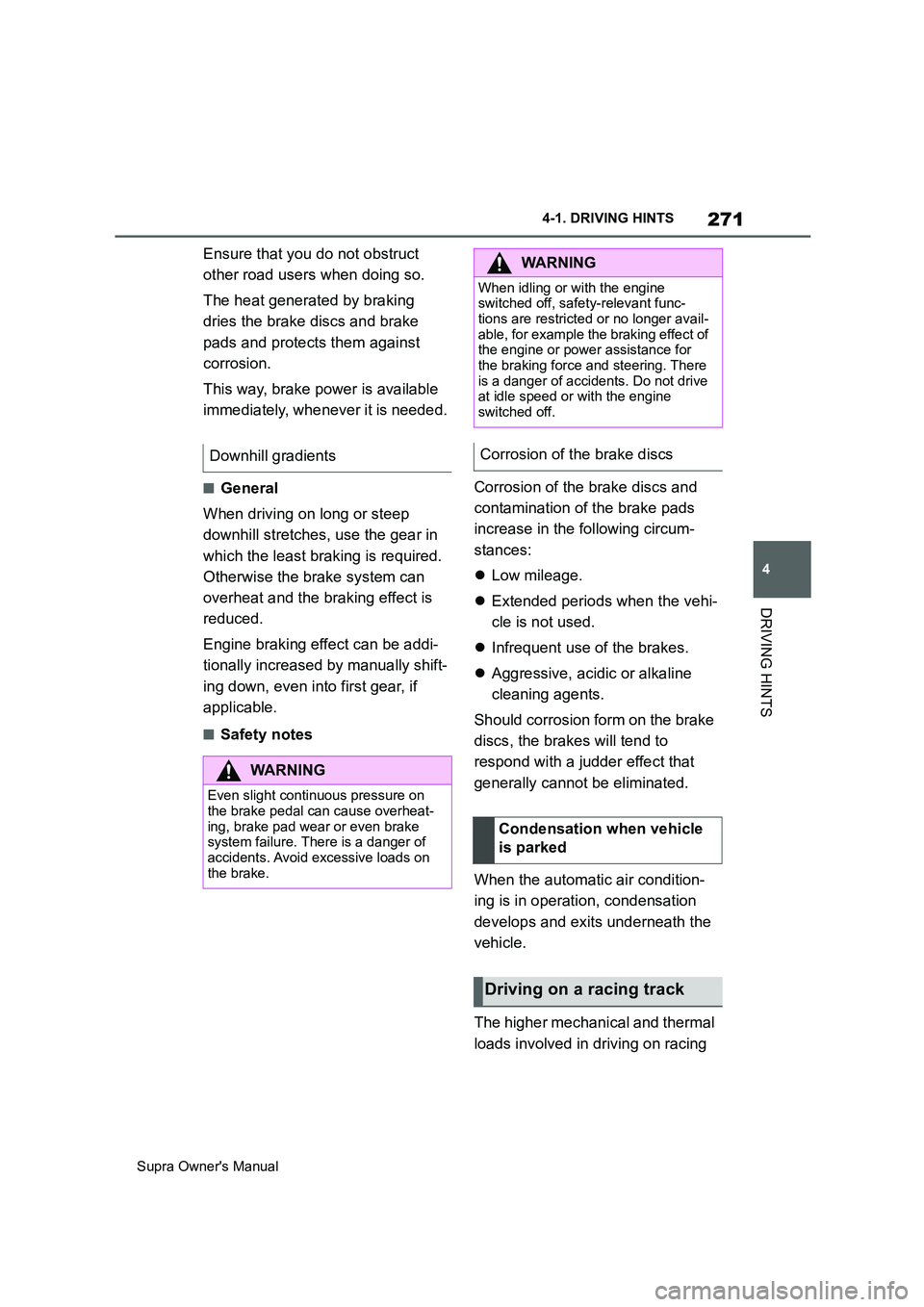
271
4
Supra Owner's Manual4-1. DRIVING HINTS
DRIVING HINTS
Ensure that you do not obstruct
other road users when doing so.
The heat generated by braking
dries the brake discs and brake
pads and protects them against
corrosion.
This way, brake power is available
immediately, whenever it is needed.
■General
When driving on long or steep
downhill stretches, use the gear in
which the least braking is required.
Otherwise the brake system can
overheat and the braking effect is
reduced.
Engine braking effect can be addi-
tionally increased by manually shift-
ing down, even into first gear, if
applicable.
■Safety notesCorrosion of the brake discs and
contamination of the brake pads
increase in the following circum-
stances:
Low mileage.
Extended periods when the vehi-
cle is not used.
Infrequent use of the brakes.
Aggressive, acidic or alkaline
cleaning agents.
Should corrosion form on the brake
discs, the brakes will tend to
respond with a judder effect that
generally cannot be eliminated.
When the automatic air condition-
ing is in operation, condensation
develops and exits underneath the
vehicle.
The higher mechanical and thermal
loads involved in driving on racing Downhill gradients
WARNING
Even slight continuous pressure on
the brake pedal can cause overheat-
ing, brake pad wear or even brake
system failure. There is a danger of
accidents. Avoid excessive loads on
the brake.
WARNING
When idling or with the engine
switched off, safety-relevant func-
tions are restricted or no longer avail-
able, for example the braking effect of
the engine or power assistance for
the braking force and steering. There
is a danger of accidents. Do not drive
at idle speed or with the engine
switched off.
Corrosion of the brake discs
Condensation when vehicle
is parked
Driving on a racing track
Page 284 of 456

284
Supra Owner's Manual5-1. MOBILITY
In the event of a complete loss of
tyre inflation pressure, run-flat tyres
enable you to continue driving, with
certain restrictions.
The wheels are fitted with tyres
which are self-supporting to a lim-
ited degree. They may also have
special rims.
The reinforced side wall means that
the tyre keeps the vehicle mobile to
a degree even if tyre inflation pres-
sure has been lost.
Observe the notes on continuing to
drive with a flat tyre.The tyres are identified on the tyre's
side wall by RSC Runflat System
Component.
• Park the vehicle on a firm sur-
face and as far away from mov-
ing traffic as possible.
• Switch on the hazard warning
lights.
• Apply the parking brake to pre-
vent the vehicle rolling away.
• Engage the steering wheel lock
with the wheels in the
straight-ahead position.
• Have all vehicle occupants get
out of the vehicle and guide them
out of the danger area, for exam-
ple behind the crash barrier.
• Set up the warning triangle an
appropriate distance away.
Run-flat tyres
Principle
General
Safety notes
WARNING
A run-flat tyre which has low tyre infla-
tion pressure or no tyre inflation pres-
sure at all will change the vehicle's
handling characteristics, for example
there may be reduced directional sta-
bility when braking, longer braking
distances and different self-steering
characteristics. There is a danger of
accidents. Drive with care and do not
exceed a speed of 80 km/h, 50 mph.
Label
Remedying flat tyres
Safety measures
Page 286 of 456
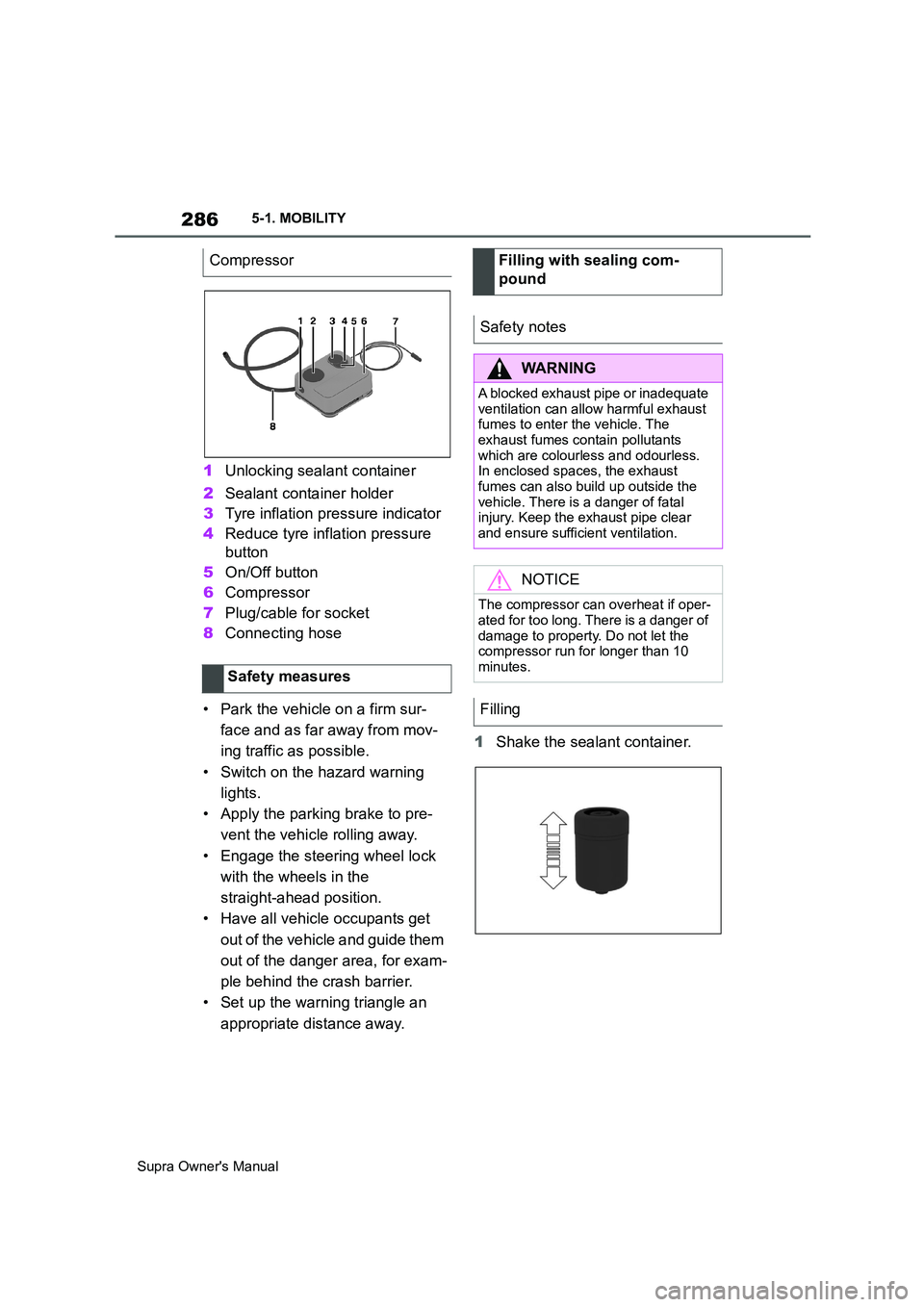
286
Supra Owner's Manual5-1. MOBILITY
1Unlocking sealant container
2Sealant container holder
3Tyre inflation pressure indicator
4Reduce tyre inflation pressure
button
5On/Off button
6Compressor
7Plug/cable for socket
8Connecting hose
• Park the vehicle on a firm sur-
face and as far away from mov-
ing traffic as possible.
• Switch on the hazard warning
lights.
• Apply the parking brake to pre-
vent the vehicle rolling away.
• Engage the steering wheel lock
with the wheels in the
straight-ahead position.
• Have all vehicle occupants get
out of the vehicle and guide them
out of the danger area, for exam-
ple behind the crash barrier.
• Set up the warning triangle an
appropriate distance away.1Shake the sealant container. Compressor
Safety measures
Filling with sealing com-
pound
Safety notes
WARNING
A blocked exhaust pipe or inadequate
ventilation can allow harmful exhaust
fumes to enter the vehicle. The
exhaust fumes contain pollutants
which are colourless and odourless.
In enclosed spaces, the exhaust
fumes can also build up outside the
vehicle. There is a danger of fatal
injury. Keep the exhaust pipe clear
and ensure sufficient ventilation.
NOTICE
The compressor can overheat if oper-
ated for too long. There is a danger of
damage to property. Do not let the
compressor run for longer than 10
minutes.
Filling
Page 297 of 456
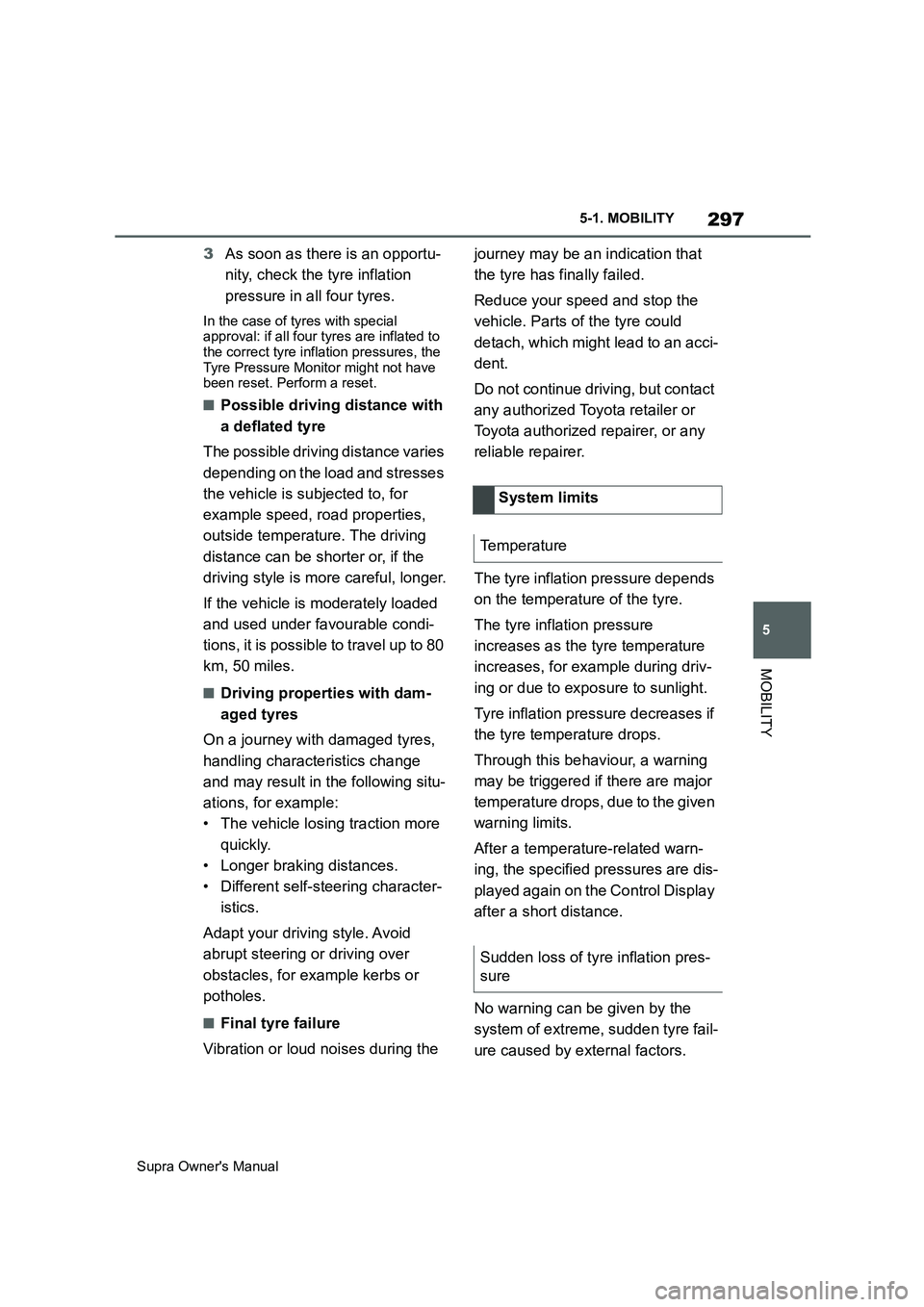
297
5
Supra Owner's Manual5-1. MOBILITY
MOBILITY
3As soon as there is an opportu-
nity, check the tyre inflation
pressure in all four tyres.
In the case of tyres with special
approval: if all four tyres are inflated to
the correct tyre inflation pressures, the
Tyre Pressure Monitor might not have
been reset. Perform a reset.
■Possible driving distance with
a deflated tyre
The possible driving distance varies
depending on the load and stresses
the vehicle is subjected to, for
example speed, road properties,
outside temperature. The driving
distance can be shorter or, if the
driving style is more careful, longer.
If the vehicle is moderately loaded
and used under favourable condi-
tions, it is possible to travel up to 80
km, 50 miles.
■Driving properties with dam-
aged tyres
On a journey with damaged tyres,
handling characteristics change
and may result in the following situ-
ations, for example:
• The vehicle losing traction more
quickly.
• Longer braking distances.
• Different self-steering character-
istics.
Adapt your driving style. Avoid
abrupt steering or driving over
obstacles, for example kerbs or
potholes.
■Final tyre failure
Vibration or loud noises during the journey may be an indication that
the tyre has finally failed.
Reduce your speed and stop the
vehicle. Parts of the tyre could
detach, which might lead to an acci-
dent.
Do not continue driving, but contact
any authorized Toyota retailer or
Toyota authorized repairer, or any
reliable repairer.
The tyre inflation pressure depends
on the temperature of the tyre.
The tyre inflation pressure
increases as the tyre temperature
increases, for example during driv-
ing or due to exposure to sunlight.
Tyre inflation pressure decreases if
the tyre temperature drops.
Through this behaviour, a warning
may be triggered if there are major
temperature drops, due to the given
warning limits.
After a temperature-related warn-
ing, the specified pressures are dis-
played again on the Control Display
after a short distance.
No warning can be given by the
system of extreme, sudden tyre fail-
ure caused by external factors.System limits
Temperature
Sudden loss of tyre inflation pres-
sure
Page 301 of 456

301
5
Supra Owner's Manual5-1. MOBILITY
MOBILITY
3After screwing on the wheel
stud, remove the adapter again
and stow it.
• Park the vehicle on firm and-
non-slip ground at a safe dis-
tance from traffic.
• Switch on the hazard warning
lights.
• Apply the parking brake.
• Engage a gear or select selector
lever position P.
• As soon as the traffic permits,
have all vehicle occupants get
out of the vehicle and guide them
out of the danger area, for exam-
ple behind the crash barrier.
• Depending on the equipment,
take the wheel change tools and,
if necessary, the emergency
wheel out of the vehicle.
• If applicable, set up warning tri-
angle or flashing light at the cor-
rect distance.
• Additionally protect the vehicle
against rolling away.
• Undo the wheel studs by half a
turn.The jacking points are located in
the marked positions.
1Hold the jack with one hand,
arrow 1, and grasp the jack
crank or lever with your other
hand, arrow 2.
2Guide the jack into the rectangu-
lar recess of the jacking point Preparing the vehicleJacking points
Raising vehicle
WARNING
Your hands or fingers could get
trapped when using the jack. There is
a danger of injury. Keep your hands in
the described position when using the
jack, and do not change this position.
Page 303 of 456
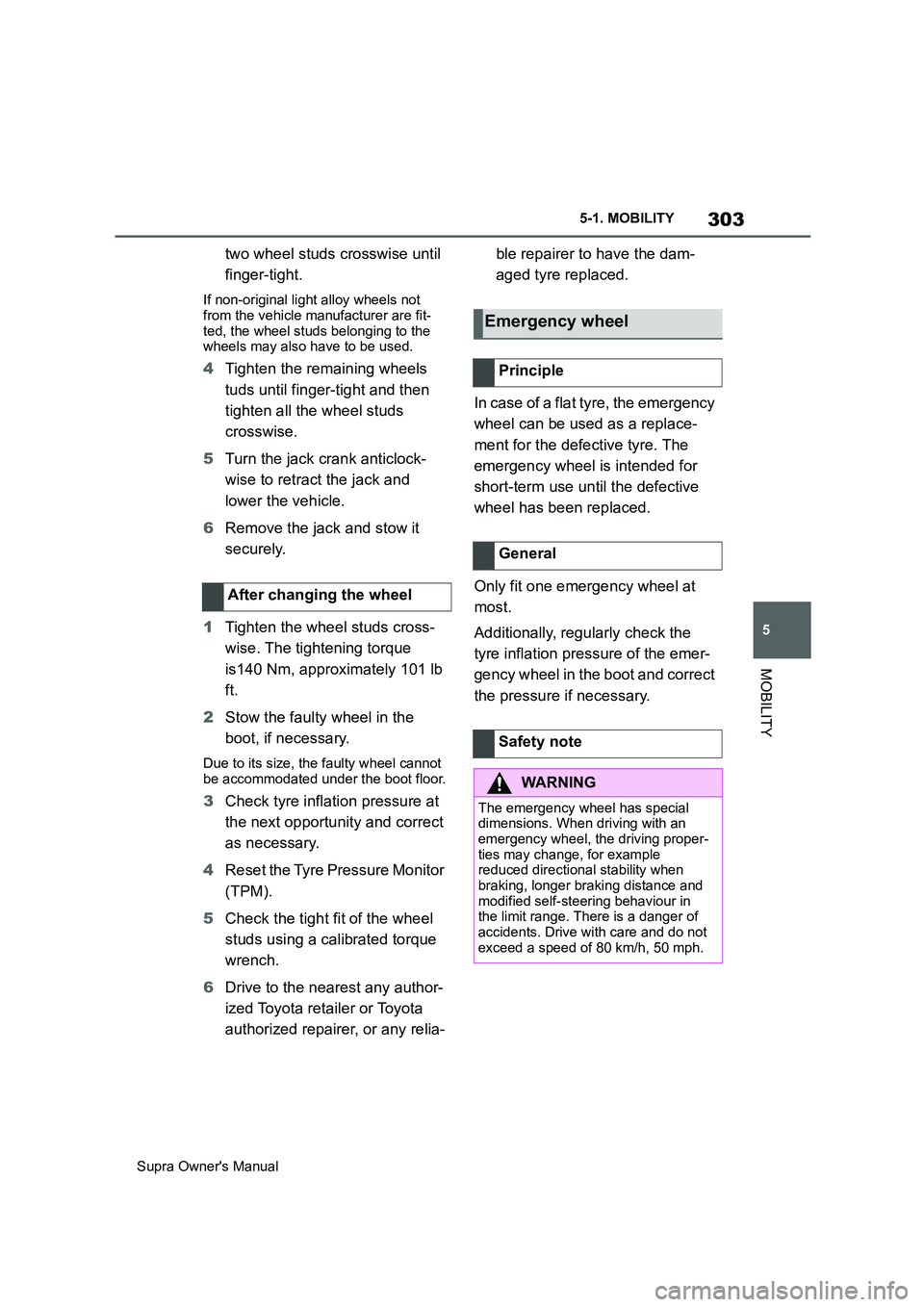
303
5
Supra Owner's Manual5-1. MOBILITY
MOBILITY
two wheel studs crosswise until
finger-tight.
If non-original light alloy wheels not
from the vehicle manufacturer are fit-
ted, the wheel studs belonging to the
wheels may also have to be used.
4Tighten the remaining wheels
tuds until finger-tight and then
tighten all the wheel studs
crosswise.
5Turn the jack crank anticlock-
wise to retract the jack and
lower the vehicle.
6Remove the jack and stow it
securely.
1Tighten the wheel studs cross-
wise. The tightening torque
is140 Nm, approximately 101 lb
ft.
2Stow the faulty wheel in the
boot, if necessary.
Due to its size, the faulty wheel cannot
be accommodated under the boot floor.
3Check tyre inflation pressure at
the next opportunity and correct
as necessary.
4Reset the Tyre Pressure Monitor
(TPM).
5Check the tight fit of the wheel
studs using a calibrated torque
wrench.
6Drive to the nearest any author-
ized Toyota retailer or Toyota
authorized repairer, or any relia-ble repairer to have the dam-
aged tyre replaced.
In case of a flat tyre, the emergency
wheel can be used as a replace-
ment for the defective tyre. The
emergency wheel is intended for
short-term use until the defective
wheel has been replaced.
Only fit one emergency wheel at
most.
Additionally, regularly check the
tyre inflation pressure of the emer-
gency wheel in the boot and correct
the pressure if necessary. After changing the wheel
Emergency wheel
Principle
General
Safety note
WARNING
The emergency wheel has special
dimensions. When driving with an
emergency wheel, the driving proper-
ties may change, for example
reduced directional stability when
braking, longer braking distance and
modified self-steering behaviour in
the limit range. There is a danger of
accidents. Drive with care and do not
exceed a speed of 80 km/h, 50 mph.
Page 310 of 456
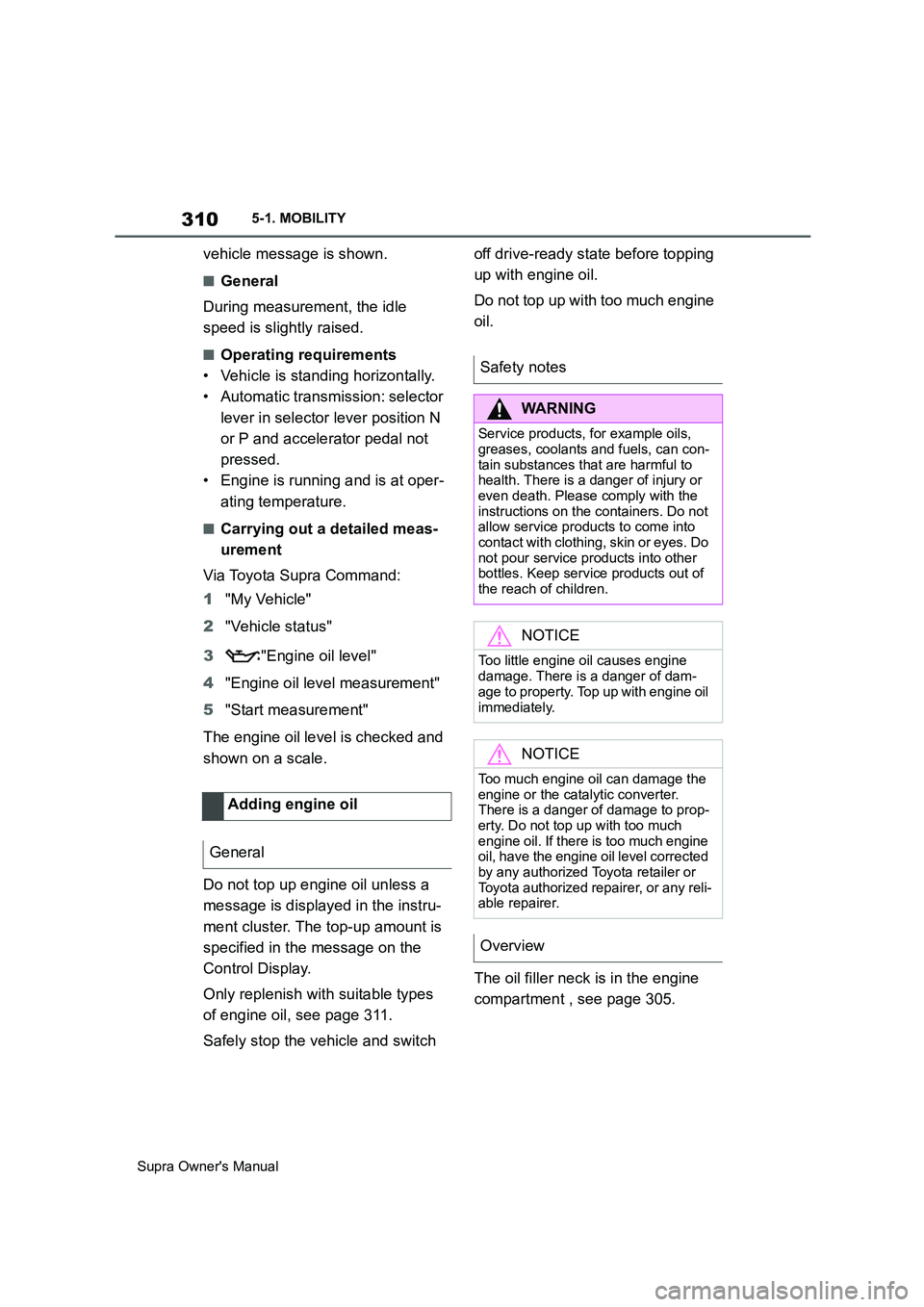
310
Supra Owner's Manual5-1. MOBILITY
vehicle message is shown.
■General
During measurement, the idle
speed is slightly raised.
■Operating requirements
• Vehicle is standing horizontally.
• Automatic transmission: selector
lever in selector lever position N
or P and accelerator pedal not
pressed.
• Engine is running and is at oper-
ating temperature.
■Carrying out a detailed meas-
urement
Via Toyota Supra Command:
1"My Vehicle"
2"Vehicle status"
3"Engine oil level"
4"Engine oil level measurement"
5"Start measurement"
The engine oil level is checked and
shown on a scale.
Do not top up engine oil unless a
message is displayed in the instru-
ment cluster. The top-up amount is
specified in the message on the
Control Display.
Only replenish with suitable types
of engine oil, see page 311.
Safely stop the vehicle and switch off drive-ready state before topping
up with engine oil.
Do not top up with too much engine
oil.
The oil filler neck is in the engine
compartment , see page 305. Adding engine oil
General
Safety notes
WARNING
Service products, for example oils,
greases, coolants and fuels, can con-
tain substances that are harmful to
health. There is a danger of injury or
even death. Please comply with the
instructions on the containers. Do not
allow service products to come into
contact with clothing, skin or eyes. Do
not pour service products into other
bottles. Keep service products out of
the reach of children.
NOTICE
Too little engine oil causes engine
damage. There is a danger of dam-
age to property. Top up with engine oil
immediately.
NOTICE
Too much engine oil can damage the
engine or the catalytic converter.
There is a danger of damage to prop-
erty. Do not top up with too much
engine oil. If there is too much engine
oil, have the engine oil level corrected
by any authorized Toyota retailer or
Toyota authorized repairer, or any reli-
able repairer.
Overview
Page 313 of 456
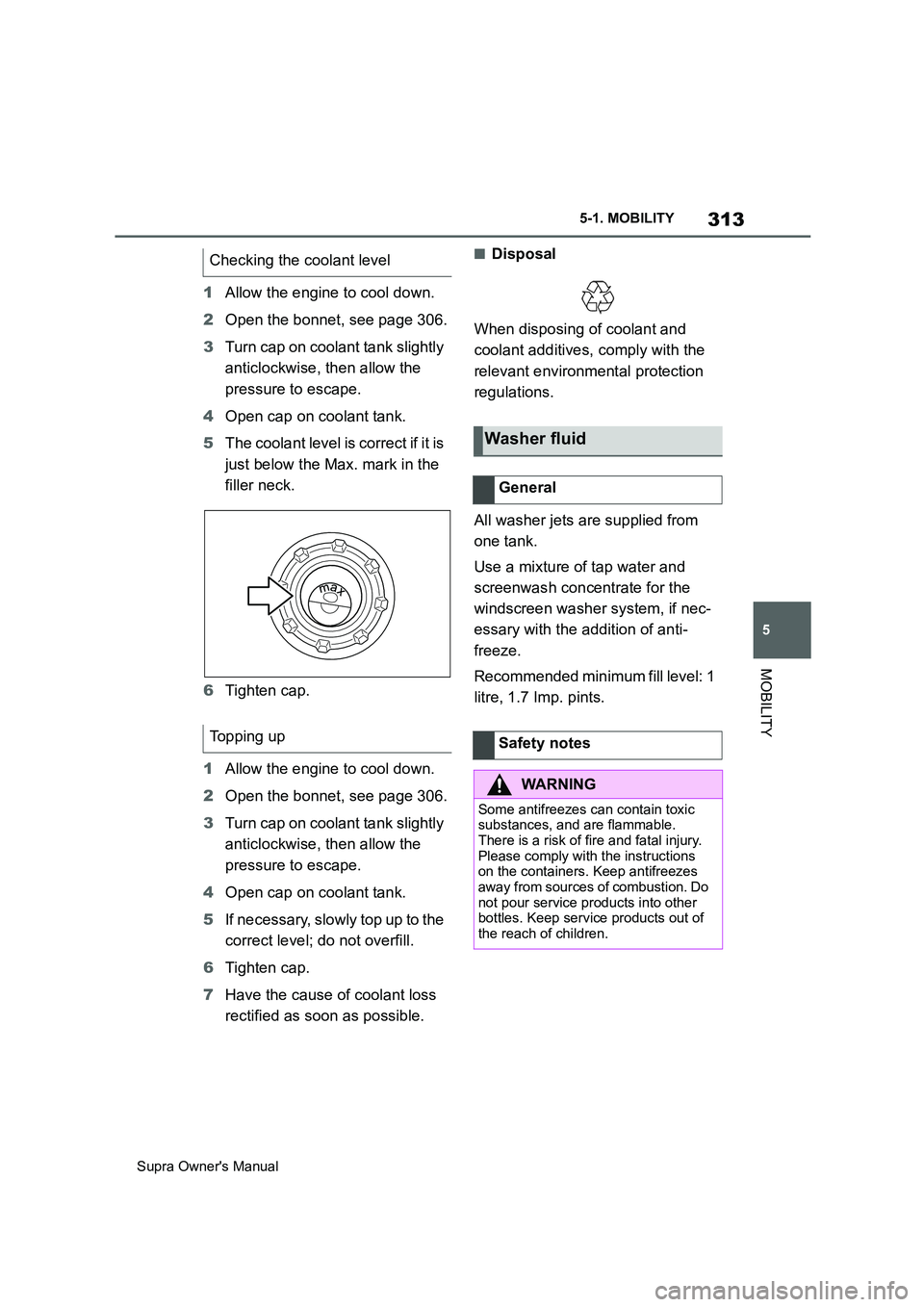
313
5
Supra Owner's Manual5-1. MOBILITY
MOBILITY
1Allow the engine to cool down.
2Open the bonnet, see page 306.
3Turn cap on coolant tank slightly
anticlockwise, then allow the
pressure to escape.
4Open cap on coolant tank.
5The coolant level is correct if it is
just below the Max. mark in the
filler neck.
6Tighten cap.
1Allow the engine to cool down.
2Open the bonnet, see page 306.
3Turn cap on coolant tank slightly
anticlockwise, then allow the
pressure to escape.
4Open cap on coolant tank.
5If necessary, slowly top up to the
correct level; do not overfill.
6Tighten cap.
7Have the cause of coolant loss
rectified as soon as possible.
■Disposal
When disposing of coolant and
coolant additives, comply with the
relevant environmental protection
regulations.
All washer jets are supplied from
one tank.
Use a mixture of tap water and
screenwash concentrate for the
windscreen washer system, if nec-
essary with the addition of anti-
freeze.
Recommended minimum fill level: 1
litre, 1.7 Imp. pints. Checking the coolant level
Topping up
Washer fluid
General
Safety notes
WARNING
Some antifreezes can contain toxic
substances, and are flammable.
There is a risk of fire and fatal injury.
Please comply with the instructions
on the containers. Keep antifreezes
away from sources of combustion. Do
not pour service products into other
bottles. Keep service products out of
the reach of children.